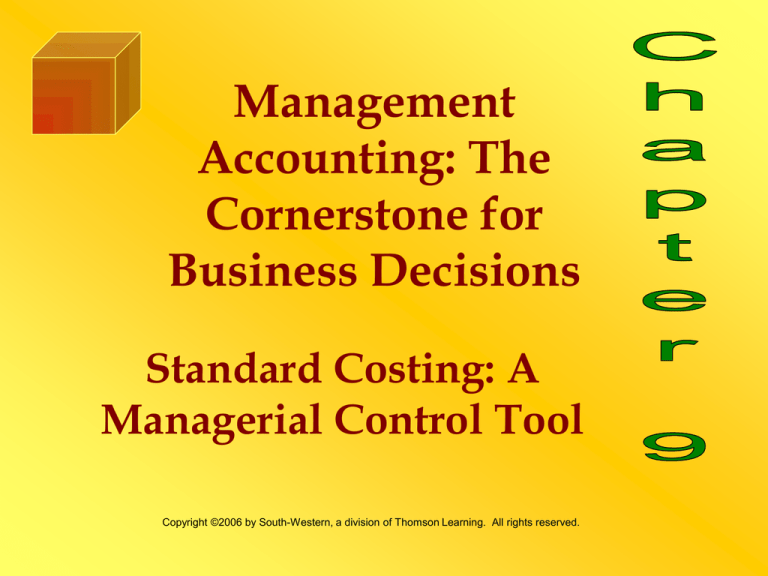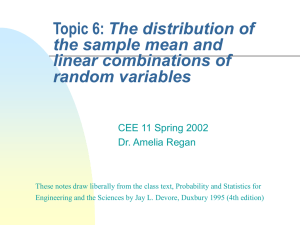
Management
Accounting: The
Cornerstone for
Business Decisions
Standard Costing: A
Managerial Control Tool
Copyright ©2006 by South-Western, a division of Thomson Learning. All rights reserved.
Learning Objectives
1. Explain how unit standards are set and
why standard cost systems are adopted.
2. Explain the purpose of a standard cost
sheet.
3. Describe the basic concepts underlying
variance analysis and explain when
variances should be investigated.
4. Compute the materials variances and
explain how they are used for control.
Learning Objectives
5. Compute the labor variances and
explain how they are used for control.
6. (Appendix 9A) Prepare journal entries
for materials and labor variances.
7. (Appendix 9B) Define kaizen and target
costing and explain their relationship to
traditional standard costing.
What three ways are used
to develop standards?
Define Ideal and Currently
Attainable Standards
◙ Ideal Standards
Demands maximum efficiency and is
achievable only when everything operates
perfectly. There are no breakdowns, slack, or
skill failures.
◙ Currently Attainable Standards
Are achievable under efficient operating
conditions, but allowances are made for
breakdowns, interruptions, some mistakes
and so on.
Illustrate Types of Standards
Why have a standard cost
system?
◙ It enhances planning and control and
improves performance measurement
◙ Allows comparison of actual and budget
and analysis of variances (differences)
◙ Broken down into price and efficiency
variances
◙ Managers over inputs than prices
◙ Standard cost systems are widely used
Create a Table of Cost
Assignment Approaches
Manufacturing Costs
Direct
materials
Direct
labor
Overhead
Actual Costing
Actual
Actual
Actual
Normal Costing
Actual
Actual
Budgeted
Standard
Standard
Standard
Standard Costing
How to compute standard
9-1 quantities allowed (SQ & SH)
Assume that 200,000 packages of corn chips are produced
during first week of April. The unit quantity standard is
18 ounces of yellow corn per package. The unit quantity
standard for machine operators is 0.01 DLH per package
produced.
REQUIRED: How much yellow corn and how many operator
hours should have been used or the actual output of
200,000 packages?
Calculation:
Corn allowed SQ = Unit quantity standard x Actual output
= 18 oz. x 200,000 = 3,600,000 oz.
Operator hours allowed
SH = Unit labor standard x Actual output
= 0.01 DLH x 200,000 = 2,000 DLH
Brief Describe the Total Budget
Variance, Price & Efficiency
Variance
◙ The actual cost – The planned cost
= (AP x AQ) – (SP x SQ)
It is also call the TOTAL VARIANCE
◙ The Price or Rate variance is the
(Actual price – Standard Price) x Actual
number of units used =(AP – SP) x AQ
◙ The Usage or Efficiency variance is the
(Actual Quantity – Standard Quantity) x
Standard Price = (AQ – SQ) x SP
Draw the General Variance
Model
1. AQ X AP
(Actual Quantity
Of input at
Actual Price)
2. AQ X SP
(Actual Quantity
Of input at
Standard Price)
Price Variance
(1 - 2)
3. SQ X SP
(Standard Quantity
Of input at
Standard Price)
Usage Variance
(2 – 3)
Total Variance
(1 – 3)
9-2
How to use control limits to
trigger a variance investigation
Information: Standard costs: $100,000; allowable
deviation +10,000; actual costs for six months:
June
$97,500
September $102,500
July
105,000
October
107,500
August
95,000
November 112,500
Required: Plot the actual costs over time against
the upper and lower control lines. Determine
when a variance should be investigated.
Calculation: Appears on the following two
slides.
9-2
Decisions to Investigate
9-2
Variance Investigation
9-3
How to calculate the total
variance for materials
Unit standards from Exhibit 9-3; the actual results
from the first week of September are below:
Actual production 97,000 bags of corn chips
Actual cost of corn 1,560,000 oz. at $0.015 = $23,400
Actual cost of labor 720 hours at $8.35 = $6,012
REQUIRED: Calculate the total variances for corn
and labor for the first week in September.
Calculation: On the following slide
9-3
How to calculate the total
variance for materials
Actual Costs
Budgeted Costs
AQ x AP
$
23,400
SQ x SP
$
17,460
Total Variance
AQ x AP - SQ x SP
$
Corn: SQ = 18 x 97,000 = 1,746,000 oz.
Corn: $0.01 x 1,746,000 = $17,460
5,940
9-4
How to calculate the total
variance for materials
Units standards from Exhibits 9-2, the
actual results from the first week of
September:
Actual production 97,000 bags of corn
chips
Actual cost of corn 1,560,000 oz. @ $0.015
REQUIRED: Calculate the materials price
and usage variances use the 3 pronged
(columnar) and formula approaches.
9-4
How to calculate the total
variance for materials
Calculation:
A. Formulas (recommended approach for
materials variances because materials purchases
may differ from materials used.
MPV = (AP – SP)AQ
= ($0.015 - $0.01)1,560,000
= $7,800 U
MUV = (AQ –SQ)SP
= (1,560,000 – 1,746,000)$0.01
= $1,860 F
9-4
How to calculate the total
variance for materials
1. AQ X AP
2. AQ X SP
3. SQ X SP
(Actual Quantity
(Actual Quantity (Standard Quantity
at Actual Price) At Standard Price) at Standard Price)
1,560,000 x
1,560,000 x
1,746,000 x
$0.015 = $23,400
$0.01 = $15,600
$0.01 = $17,460
Price Variance
(1 - 2)
$7,800 U
Usage Variance
(2 – 3)
$1,860 F
Total Variance
(1 – 3)
$5,940 U
Discuss Using Materials
Variance Information
◙ Responsibility for materials price
variance
◙ Usually with purchasing agents
◙ Analysis of materials price variance
◙ Is it significant or not?
◙ Responsibility for the materials usage
variance
◙ Usually production manager is responsible
◙ Analysis of materials usage variance
◙ Who is it assignable to?
9-5
How to calculate the total
variance for labor
Unit standards from Exhibit 9-3; the actual
results from the first week of September
are below:
Actual production 97,000 bags of corn
chips
Actual cost of labor 720 hours at $8.35 =
$6,012
REQUIRED: Calculate the total variances
for labor for the first week in September.
Calculation: On the following slide
How to calculate the total
variance for materials
9-5
Actual Costs
Budgeted Costs
AQ x AP
$
6,012
SQ x SP
$
7,760
Total Variance
AQ x AP - SQ x SP
$
Labor: SQ = .01 x 97,000 = 970 hours
Labor: $8.00 x 970 = $7,760
1,748
9-6
How to calculate the labor
variances: formula & columnar
approaches
Units standards from Exhibits 9-3, the actual
results from the first week of September:
Actual production 97,000 bags of corn chips
Actual cost of labor 720 hours @ $8.35
REQUIRED: Calculate the labor rate and
efficiency variances use the 3 pronged
(columnar) and formula approaches.
9-6
How to calculate the labor
variances: formula & columnar
approaches
Calculation:
LRV = (AR – SR)AH
= ($8.35 - $8.00)720
= $252 U
LEV = (AH –SH)SR
= (720 – 970)$8.00
= $2,000 F
9-6
How to calculate the labor
variances: formula & columnar
approaches
1. AH X AR
(Actual Quantity
at Actual Price)
720 x $8.35 =
$6,012
2. AH X SR
3. SH X SR
(Actual Quantity (Standard Quantity
At Standard Price) at Standard Price)
720 x $8.00 =
970 x $8.00 =
$5,760
$7,760
Price Variance
(1 - 2)
$252 U
Usage Variance
(2 – 3)
$2,000 F
Total Variance
(1 – 3)
$1,748 F
Discuss Using Labor
Variance Information
◙ Responsibility for labor rate variance
◙ Determined primarily by external forces
◙ Affected by unions, labor contracts and
seniority
◙ Analysis of labor rate variance
◙ Responsibility for labor efficiency variance
◙ Managers are responsible for the productive
use of labor
◙ Analysis of labor efficiency variance







